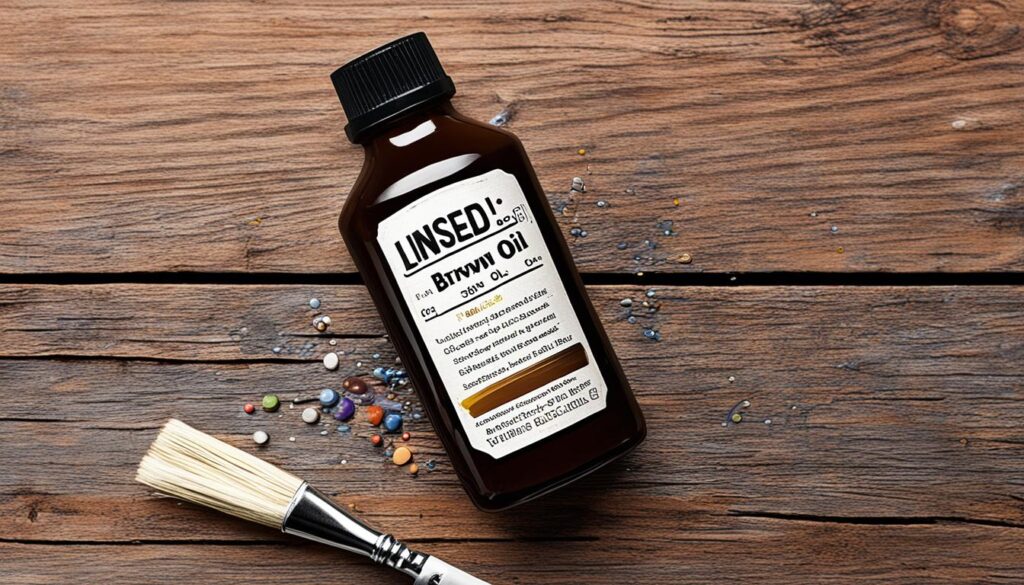Linseed oil emits a distinct fragrance driven by volatile organic compounds (VOCs) such as aldehydes. The scent ranges from mild in cold-pressed oils to a more chemical-like odor in industrially processed variants. This olfactory profile can persist for weeks to months as the oil cures. Factors like temperature and humidity influence the rate of off-gassing. While ventilation and sealing can mitigate the smell, the unmistakable aroma is often unavoidable. Safety precautions should be taken to avoid adverse health effects from prolonged exposure to the fumes. For those sensitive to odors, exploring milder alternatives like walnut or safflower oil could be beneficial.
Does Linseed Oil Smell
Linseed oil, renowned for its utility in artistic and woodworking applications, possesses a distinctive odor characterized by the presence of volatile organic compounds such as aldehydes. The scent variations of linseed oil are considerable, ranging from the mild aroma of cold-pressed varieties to the more pungent, chemical-like smell of industrially processed oils, often exacerbated by chemical additives.
The odor duration of linseed oil is remarkably prolonged, with the initial intensity diminishing over a span of weeks, though the off-gassing process can continue subtly for years. This odor can occasionally become unpleasantly fishy, a sign of the oil turning rancid. To manage these olfactory challenges, effective ventilation tips include allowing the oil to off-gas in a well-ventilated area for at least 30 days.
Sealing techniques, such as applying multiple coats of clear shellac, can effectively lock in the smell, mitigating its persistence. However, caution is advised due to combustion risks associated with oil-soaked rags, necessitating proper handling and storage.
Despite these considerations, the cold pressed benefits of linseed oil, including its less pronounced scent, make it a favorable choice for many users.
How Long Does the Smell of Linseed Oil Typically Last
Understanding the longevity of linseed oil‘s aroma requires an examination of the factors that influence its persistence, including the type of linseed oil used, the application techniques, and the surrounding environmental conditions.
The odor duration of linseed oil can extend from several weeks to months, primarily due to the curing process, which involves oxidation. This process releases volatile organic compounds (VOCs), contributing to the lingering scent.
Environmental factors such as temperature and humidity greatly affect the rate of off-gassing. Higher temperatures and lower humidity can expedite the curing process, thereby reducing the odor duration. Conversely, high humidity and cooler temperatures can prolong the smell, making humidity control vital.
Boiled linseed oil (BLO), known for its faster drying properties, can still emit a persistent odor for weeks or even months.
To mitigate the smell, employing effective ventilation tips is essential. Allowing the oil to off-gas in a well-ventilated area for at least 30 days can significantly diminish the odor. Applying heat and ensuring proper airflow can further accelerate this process.
Additionally, shellac sealing can effectively trap the odor, though multiple coats may be necessary for complete efficacy. Understanding these dynamics enables better management of linseed oil’s aromatic footprint.
How to Remove the Smell of Linseed Oil
To effectively remove the smell of linseed oil, it is essential to harness a combination of ventilation, sealing techniques, and specialized treatments to neutralize the persistent VOCs responsible for the odor. Maximizing fresh air flow is paramount; place the item in a well-ventilated space, where natural off-gassing can occur. Elevating temperature and reducing humidity can expedite this process.
Sealing the odor with a clear shellac coat provides an effective barrier. Apply 1-3 coats, ensuring each layer dries thoroughly. Zinsser Bullseye Shellac is highly effective for this purpose. If the odor lingers, mineral spirits can be used to wipe the surface, followed by additional shellac applications.
DIY remedies and aromatherapy tricks also play a role in scent elimination. Essential oils like lavender or eucalyptus serve as natural deodorizers, contributing to home fragrance and overall odor control. Incorporating these elements can effectively mask and neutralize the lingering smell of linseed oil.
| Method | Description |
|---|---|
| Ventilation | Natural off-gassing in a well-ventilated area, with increased temperature |
| Sealing Techniques | Applying multiple coats of clear shellac to seal in odor |
| Specialized Treatments | Wiping with mineral spirits, using essential oils as natural deodorizers |
Through a combination of these strategies, the persistent smell of linseed oil can be substantially mitigated.
Can Linseed Oil Fumes Be Harmful to Health
Despite the non-toxic nature of linseed oil, certain considerations regarding its fumes must be addressed to guarantee safe usage and minimize potential health risks. Linseed oil contains volatile organic compounds (VOCs) such as aldehydes and hydrocarbons, which, although not highly toxic, can still lead to health effects, particularly in individuals with heightened odor sensitivity. These compounds can cause headaches or respiratory issues in enclosed spaces, necessitating proper ventilation tips to establish a well-ventilated environment during use.
Moreover, prolonged skin contact with linseed oil can result in skin irritation or dermatitis for some users. Safety precautions, including the use of gloves and ensuring minimal skin exposure, are highly recommended to mitigate these risks. Additionally, individuals prone to allergic reactions should exercise caution and perhaps seek alternatives.
The most pressing of toxicity concerns is the potential fire hazards associated with linseed oil. Oil-soaked rags pose a significant risk of spontaneous combustion and should be handled with care—stored in metal containers with water or laid flat to dry, thereby minimizing fire risks. Adhering to these handling precautions ensures the safe and effective use of linseed oil while mitigating health and safety concerns.
Are There Any Alternatives to Linseed Oil with a Milder Scent
Given the potential health risks and fire hazards associated with linseed oil fumes, exploring alternatives with milder scents becomes an important consideration for users seeking safer options. Walnut oil, safflower oil, poppy seed oil, tung oil, and mineral oil are excellent substitutes, each offering unique benefits for various applications such as painting and wood finishing.
Walnut oil benefits include a clear, pale yellow color and a slower drying time, useful for painting techniques that require prolonged blending. In contrast, safflower oil uses highlight its ability to maintain the brightness of lighter colors, making it ideal for whites and blues. Poppy seed oil advantages include its flexibility and durability, producing a clear film with minimal odor.
Tung oil applications are renowned for their water resistance and durability, important in woodworking projects. Its mild scent and matte finish enhance the natural beauty of wood. Mineral oil, though non-drying, is prized for its safety precautions, especially in cooking and treating kitchen items.
| Oil Type | Characteristics | Applications |
|---|---|---|
| Walnut Oil | Clear, pale yellow, slower drying | Painting, wood finishing |
| Safflower Oil | Very clear, minimal yellowing | Painting (lighter colors), wood finishing |
| Poppy Seed Oil | Clear, durable, mild odor | Final painting layers, wood finishing |
| Tung Oil | Water-resistant, mild odor | Woodworking projects, painting |
| Mineral Oil | Odorless, non-toxic | Treating cutting boards, kitchen utensils |
Comparing walnut vs safflower or poppy seed vs tung oil assists users in selecting the appropriate oil for their specific needs.
Welcome to WoodCraftYard.com, your one-stop destination for all things woodworking! I’m Oliver Candler, a dedicated woodworking aficionado and the creative mind behind this virtual woodworking haven. With a deep-rooted love for craftsmanship and a keen eye for detail, I am on a mission to share my passion for woodworking with fellow enthusiasts like yourself.
As a seasoned woodworker, I am committed to providing you with valuable insights, practical tips, and inspiring project ideas to help you unleash your creativity and master the art of woodworking. Whether you’re a seasoned pro or just starting out on your woodworking journey, join me as we carve, sand, and saw our way through the world of woodworking together.
Let’s embark on this woodworking adventure, where every knot, grain, and finish tells a unique story. Together, let’s craft, create, and build something truly extraordinary at WoodCraftYard.com!


